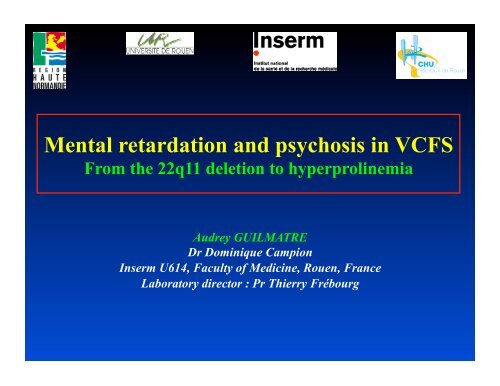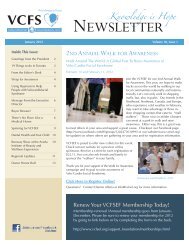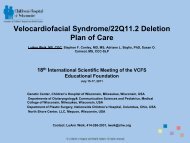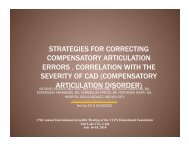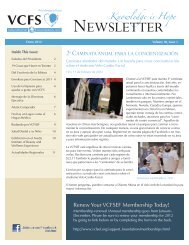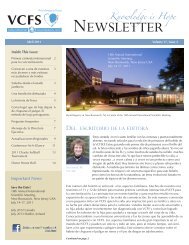Mental retardation and psychosis in VCFS From the 22q11 deletion ...
Mental retardation and psychosis in VCFS From the 22q11 deletion ...
Mental retardation and psychosis in VCFS From the 22q11 deletion ...
Create successful ePaper yourself
Turn your PDF publications into a flip-book with our unique Google optimized e-Paper software.
!<strong>Mental</strong> <strong>retardation</strong> <strong>and</strong> <strong>psychosis</strong> <strong>in</strong> <strong>VCFS</strong><strong>From</strong> <strong>the</strong> <strong>22q11</strong> <strong>deletion</strong> to hyperprol<strong>in</strong>emiaAudrey GUILMATREDr Dom<strong>in</strong>ique CampionInserm U614, Faculty of Medic<strong>in</strong>e, Rouen, FranceLaboratory director : Pr Thierry Frébourg
THE 22Q11 DELETION SYNDROME- Facial dysmorphism- Cardiac defects- Thymus hypoplasia- Palatal cleftPsychosis <strong>in</strong> 10-30% of<strong>VCFS</strong> patientsPolymalformative SyndromeVCF syndrome(<strong>22q11</strong>DS) : <strong>the</strong> mostfrequent micro<strong>deletion</strong> <strong>in</strong> <strong>the</strong> population(1/4000)Detection of <strong>the</strong> <strong>22q11</strong><strong>deletion</strong> by FISHMild to moderate mental<strong>retardation</strong> <strong>in</strong> 50% of<strong>VCFS</strong> patients
14,5715,515,615,815,9616,0316,2616,3116,3516,5916,6516,716,8416,871717,3117,6317,7818,519,1520,143 Mb <strong>deletion</strong>CECR1TUBA8USP18PRODHDGCR5DGCR2GSCLHIRANLVCFUFD1LPNUTL1TBX1GNB1LCOMTARVCFRANBP1ZNF74PIK4CASNAP29UBE2L3VPREB1BCR______________________THE <strong>22q11</strong> REGION
PRODH AND HYPERPROLINEMIAL - prol<strong>in</strong>ePROLINEDEHYDROGENASEΔ -1- pyrrol<strong>in</strong>e - 5 – carboxylate (P5C)Type 1 Hyperprol<strong>in</strong>emia(MIM 239500)NAD +NADH + H +P5CDEHYDROGENASEType II Hyperprol<strong>in</strong>emia(MIM 239510)GlutamateCO 2γ am<strong>in</strong>obutyric acid (GABA)
MISSENSE MUTATIONS IN THE PRODH GENEQ19PR185WT275N ?L289M23 4 5 6 7 89A58T ?R431H R453C T466M Q521E10 11121314 15P406LL441P A455S A472T
GENE DOSAGE VARIATION: DELETION OF 350 kbAT THE PRODH LOCUSUSP18DGCR6 PRODHLOC200301 DGS-A DGCR2PRODH-P DGCR6 LCENLCR22TEL234 kb16 kb1180 kbFrequency:1/250 <strong>in</strong> <strong>the</strong>generalpopulationDeletion of350 kbUSP18 DGCR2 PRODH-P DGCR6 LCENTEL
MOLECULAR BASIS OF TYPE IHYPERPROLINEMIAPhenotype : severe hyperprol<strong>in</strong>emia is associated with mental<strong>retardation</strong> <strong>and</strong> epilepsyPlasma Prol<strong>in</strong>e : 800 µmol/LPlasma Prol<strong>in</strong>e : 1255 µmol/LL441P/L441PPlasma Prol<strong>in</strong>e : 2246 µmol/LPRODH Del/DelJacquet et al. 2003, Hum Mol Genet.
TYPE 1 HYPERPROLINEMIA : GENOTYPE/PHENOTYPE CORRELATIONSPatient Age PhenotypePlasmaprol<strong>in</strong>e(µmol/l)PRODHgenotypePredictedresidualenzymaticactivityDum 2 Autistic features, epilepsy1515-2186del/del0%Sal5 MR, autism, epilepsy 422-1883 del/V427M+R453C0%Gal 4 MR1003L441P/Stop c550%Elk3 MR, epilepsy418-814T466M+R453C/Q19P25%Ch<strong>in</strong> 3 MR, epilepsy 750-816 P406L+R431H /R431HDir 12 epilepsy 604-862 V427M+R453C/Q19PChoFon3 Autism 256 T466M+R453C/R185W30 PDD-NOS339 T466M+R453C/R431H25%25%25%25%
CORRELATION BETWEEN HYPERPROLINEMIAAND COGNITIVE/PSYCHIATRIC SYMPTOMS INTHE VCF SYNDROME<strong>Mental</strong> <strong>retardation</strong> <strong>in</strong> 40 -50% of <strong>VCFS</strong> subjectsPsychosis <strong>in</strong> 10 - 30% of <strong>VCFS</strong> subjectsHyperprol<strong>in</strong>emia <strong>in</strong> 40 - 50% of <strong>VCFS</strong> subjectsAre cognitive impairment <strong>and</strong>/or <strong>psychosis</strong>associated with hyperprol<strong>in</strong>emia?Collaborative Study (PHRC 2003) :Paris, Leuven, Amsterdam, Marseille, Strasbourg,Montpellier, Bordeaux, Lille, Rouen
<strong>VCFS</strong> SAMPLE Inclusion : 92 subjects. Mean age 25 ± 10 years (range: 15 - 58 years) Psychiatry (SADS-LA): schizotypal personality (n=4) atypical <strong>psychosis</strong> (n=6) schizophreniform disorder (n=3) schizophrenia (n=18)36% of subjects (n=33) autism (n=2) Cognition (WAIS III): <strong>Mental</strong> <strong>retardation</strong> (IQ < 70) <strong>in</strong> 69% of subjects VIQ (66.7 ± 16.6) > PIQ (64 ± 13.5)
<strong>VCFS</strong> SUBJECTS WITH SEVERE HYPERPROLINEMIAPatient Prol<strong>in</strong>e age IQ Psychiatry O<strong>the</strong>r001 1275 34 53 Psychosis -002 1268 42 62 SZ epilepsy002 1120 48 60 SZ epilepsy004 962 24 48 - -005 739 47 45 SZ -006 718 25 45 Autism epilepsy007 707 19 45 SZ.T epilepsy
TREND FOR ASSOCIATION BETWEENHYPERPROLINEMIA AND PSYCHOSIS IN <strong>VCFS</strong>Prol<strong>in</strong>emia >300µm/L(hyperprol<strong>in</strong>emia)Prol<strong>in</strong>emia < 300µm/L(normal values)Psychosis(n=33)O<strong>the</strong>r patients(n=59)16 (48%)18 (31%)1741Chi-2, 1ddl = 2,93 p=0.08
SEVERE HYPERPROLINEMIA IS ASSOCIATED WITHMORE SEVERE MENTAL RETARDATIONHyperprol<strong>in</strong>emia > 600 µm/L(n=7)Prol<strong>in</strong>emia< 600 µm/L(n=85)QIG = 50,6 ± 7 QIG = 65,2 ± 14Significant difference: p=0.007Inverse correlation Prol<strong>in</strong>emia / IQ.r = -0.24, p = 0.02,Spearman’s test
GENOTYPE/PHENOTYPE CORRELATIONSEnzymatic activity Prol<strong>in</strong>e Phenotype>50% Normal Normal
THE OPPOSITE STRATEGY: SEARCH FORPRODH DELETIONS IN PATIENTS WITHPSYCHIATRIC DISORDERSGuilmatre et al, Archives of General Psychiatry, 2009 <strong>in</strong> press
CNVs IN PSYCHIATRIC DISORDERS Recently, wide use of array-CGH <strong>in</strong> neurological <strong>and</strong>psychiatric disorders Recurrent rare CNVs <strong>in</strong> MR, ASD <strong>and</strong> schizophrenia<strong>Mental</strong> RetardationFriedman et al, 2006, Am JHum GenetFroyen et al, 2007, HumMutatMenten et al, 2006, J MedGenetAutism SpectrumDisordersMarshall et al, 2008, Am JHum GenetSebat et al, 2007, ScienceChristian et al, 2008, BiolPsychiatrySzatmari et al, 2007, NatGenetSchizophreniaWalsh et al, 2008, ScienceConsortium IS, 2008,NatureKirov et al, 2008, Hum MolGenetXu et al, 2008, Nat GenetStefansson et al, 2008,NatureMefford et al, 2008, N EnglJ MedKirov et al, 2009, Hum MolGenet
TARGETED ANALYSIS28 c<strong>and</strong>idate loci previously identified<strong>in</strong> rare cases of MR, ASD or SZ by array-CGH studiesNeuronalmigration <strong>and</strong>growth(PTK2,TSPAN7)28 genesO<strong>the</strong>rs(ST7, MECP2,MAPT, IL1RAPL1)Synapse formation<strong>and</strong> ma<strong>in</strong>tenance(NRXN1, NLGN1,NLGN4, SHANK3,CASK, ERBB4,NRG1, DLG2,CNTN4, CNTNAP2)Neuromodulation(PRODH)Neurotransmission(DOC2A, GRIA3, GRM7,GABRA5, GABRG1,GRIP1, APBA2, SLC1A3,DPP10, DLGAP2,CHRNA7)
AIM OF THE STUDY To provide an estimate of <strong>the</strong> collective frequency of aset of recurrent/overlapp<strong>in</strong>g CNVs <strong>in</strong> three differentgroups of patients (autism, schizophrenia <strong>and</strong> mental<strong>retardation</strong>) as compared with healthy controls To assess whe<strong>the</strong>r each CNV is present <strong>in</strong> more thanone cl<strong>in</strong>ical category
SUBJECTS 247 patients with mental <strong>retardation</strong>, without anyestablished syndrome 260 patients with autism 236 patients with schizophrenia or schizoaffectivedisorder 236 healthy controls
DISEASES ASSOCIATED CNVs (11/28)Patients with autism16/2606.1%Patients with MR13/2475.3%Patients with SZ10/2364.2%Significant excess of <strong>the</strong>se CNVs <strong>in</strong> each disease groupas compared with controls(p value < 0.001, p=0.001 <strong>and</strong> p= 0.01 respectively, Fisher exact test)Individual significance for association between <strong>the</strong> 350kb PRODH<strong>deletion</strong> <strong>and</strong> autism ( p=0.02)
DISEASES ASSOCIATED CNVs: AUTISMID ChromosomallocationSize Genes <strong>in</strong>volved Type TransmissionT35 2p16.3
PRODH DELETION: GENOTYPE/PHENOTYPECORRELATION9/12 tested patients have hyperprol<strong>in</strong>emiaAll but one patients have mutations on <strong>the</strong> rema<strong>in</strong><strong>in</strong>g allele result<strong>in</strong>g <strong>in</strong>a predicted PRODH residual activity below 30%ID diagnosis144.1144.21245212746138994473745435458564626147766si301236311780968014684SZAFFSZAutismHFAAutismAutismAutismAutismAutismAutismAutismMRMRMRMRPlasma prol<strong>in</strong>e(µmol/l)538338287214312329487ND243-283ND422-1883512ND299238genotypedel/R453C+R185Wdel/Q19Pdel/R185Wdel/Q19P+A58Tdel/Q19Pdel/T275N+V427Mdel/R185W+Q19Pdel/Q19P+P30Sdel/R185W+Q19Pdel/WTdel/R453C+Q19P+A58T+V427Mdel/R185Wdel/R185W+Q19Pdel/Q19P+P30Sdel/R185W+Q19PPredicted PRODHresidual activity2%30%25%≤30%≤25%≤20%≤25%≤30%≤25%50%≤2%25%≤25%≤30%≤25%
CONCLUSION• Type I hyperprol<strong>in</strong>emia is a rare recessive disorder, result<strong>in</strong>g fromPRODH loss of function• Type I hyperprol<strong>in</strong>emia is associated with MR, epilepsy <strong>and</strong><strong>psychosis</strong>• Trend for association between hyperprol<strong>in</strong>emia <strong>and</strong> <strong>psychosis</strong> <strong>in</strong><strong>22q11</strong> DS• Inverse correlation between IQ <strong>and</strong> prol<strong>in</strong>emia <strong>in</strong> <strong>22q11</strong> DS• Individual significance reached for association between <strong>the</strong> 350kb<strong>22q11</strong> <strong>deletion</strong> spann<strong>in</strong>g <strong>the</strong> PRODH gene <strong>and</strong> autism <strong>in</strong> a casecontrolstudyPRODH <strong>deletion</strong> lead<strong>in</strong>g to hyperprol<strong>in</strong>emia is<strong>in</strong>volved <strong>in</strong> <strong>the</strong> cognitive <strong>and</strong> psychotic symptoms <strong>in</strong><strong>VCFS</strong>
Inserm U614Department of Genetics, University Hospital,Rouen, FranceSolenn LegallicValérie Drou<strong>in</strong>-GarraudAlice GoldenbergGérald<strong>in</strong>e Joly-HelasPascale Saugier-VeberDom<strong>in</strong>ique CampionThierry FrébourgACKNOWLEDGEMENTSUMR 6061 CNRS, University of Rennes I,Rennes, FranceChristèle DubourgVéronique DavidClaude BendavidSylvie OdentDepartment of Genetics, UniversityHospital, Dijon, FranceAnne-Laure MoscaLaurence FaivreInserm U619, Tours, FranceChristian AndresUniversity of Mess<strong>in</strong>a, SicilyGabriella Di RosaGaetano TortorellaCater<strong>in</strong>a ImpallomeniEva GermanoInserm U930, University Hospital,Tours, FranceFrédérique Bonnet-BrilhaultFrédéric LaumonnierCa<strong>the</strong>r<strong>in</strong>e BarthélémyDepartment of Genetics, Hospital,Le Havre, FranceValérie LayetDepartment of Research, CHSR,Rouen, FranceGaël Le VaconCentres de Ressources Autisme deHaute-Norm<strong>and</strong>ie (A. Rosier), deBourgogne (JM P<strong>in</strong>oit, C. Henry)CHU De MontpellierPierre Sarda


